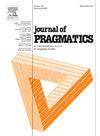Deciphering the electrophysiological signature of discourse connectives
IF 1.7
1区 文学
0 LANGUAGE & LINGUISTICS
引用次数: 0
Abstract
The discourse connectives but and so trigger specific kinds of inferences, which are characterizable as contrastive and causal, respectively. Inspired by Diane Blakemore’s notion of procedural meaning, we carry out two studies while relying on a paradigm we developed in previous work, in which 1) connectives are part of thematically bare sentences presented as a word-finding game, e.g. There is a B but there is no T, and; 2) these two connectives are compared to the less informative conjunction and. Experiment 1 instantiated our behavioral paradigm while imposing the kind of constraints one finds in an EEG study (e.g., the discourse connective is isolated and presented for a predetermined duration). The results from Experiment 1 replicated our previous behavioral findings, confirming the design's reliability. Experiment 2, an ERP study based on this modified paradigm, yielded three main findings. 1) relative to and, the discourse connectives but and so trigger a more pronounced P200 followed by Positive Slow Waves (PSW) of greater amplitude. These data point to extra inferential processing triggered by but and so relative to and. 2) the higher amplitude of the P3b component linked to negated segments following but indicates that these were anticipated more than those that follow and or so. 3) post-connective affirmative segments were, surprisingly, linked with a more pronounced P600-like component in and-trials relative to the but- and so-trials. Overall, this study allows one to more deeply appreciate the inferential processing linked to discourse connectives.
语篇连接词的电生理特征解读
语篇连接词but和so引发了特定类型的推理,分别可分为对比推理和因果推理。受Diane Blakemore的程序意义概念的启发,我们开展了两项研究,同时依赖于我们在之前的工作中开发的范式,其中1)连接词是主题裸句的一部分,以找词游戏的形式呈现,例如有B但没有T,并且;2)将这两个连接词与信息较少的连接词和进行比较。实验1实例化了我们的行为范式,同时施加了一种在脑电图研究中发现的约束(例如,话语连接被隔离并在预定的持续时间内呈现)。实验1的结果重复了我们之前的行为发现,证实了设计的可靠性。实验2,一个基于这种修正范式的ERP研究,产生了三个主要发现。1)相对于and,话语连接词but和so触发更明显的P200,随后是更大振幅的正慢波(PSW)。这些数据指向由but触发的额外推理处理,因此与and相关。2) P3b分量的较高振幅与后面的负段相关联,但表明这些比后面和左右的负段更值得期待。3)令人惊讶的是,在“和”试验中,与“但是”和“一般”试验相比,“和”试验中后连接肯定片段与p600类似成分的关联更为明显。总的来说,本研究使人们能够更深入地了解与语篇连接词相关的推理加工。
本文章由计算机程序翻译,如有差异,请以英文原文为准。
求助全文
约1分钟内获得全文
求助全文
来源期刊

Journal of Pragmatics
Multiple-
CiteScore
3.90
自引率
18.80%
发文量
219
期刊介绍:
Since 1977, the Journal of Pragmatics has provided a forum for bringing together a wide range of research in pragmatics, including cognitive pragmatics, corpus pragmatics, experimental pragmatics, historical pragmatics, interpersonal pragmatics, multimodal pragmatics, sociopragmatics, theoretical pragmatics and related fields. Our aim is to publish innovative pragmatic scholarship from all perspectives, which contributes to theories of how speakers produce and interpret language in different contexts drawing on attested data from a wide range of languages/cultures in different parts of the world. The Journal of Pragmatics also encourages work that uses attested language data to explore the relationship between pragmatics and neighbouring research areas such as semantics, discourse analysis, conversation analysis and ethnomethodology, interactional linguistics, sociolinguistics, linguistic anthropology, media studies, psychology, sociology, and the philosophy of language. Alongside full-length articles, discussion notes and book reviews, the journal welcomes proposals for high quality special issues in all areas of pragmatics which make a significant contribution to a topical or developing area at the cutting-edge of research.
 求助内容:
求助内容: 应助结果提醒方式:
应助结果提醒方式:


